We All Play / kimêtawânaw
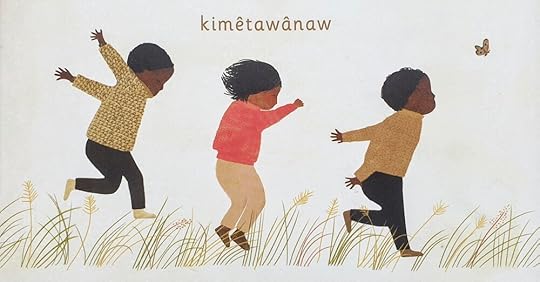
We All Play / kimêtawânaw by Julie Flett (Greystone Kids, 2021) | Illustration © 2021 by Julie Flett
This year I discovered the work of Julie Flett, and I am totally hooked.Her most recent picture book is We All Play / kimêtawânaw (Greystone Kids, 2021). Her characterisation - of both children and animals - is delightful. She describes the book as a celebration of ‘diversity and the interconnectedness of nature through an Indigenous perspective’. Because Flett is a Cree Métis author, illustrator and artist. And her work taps into (or should I say is fed by) those roots - making for some unique picture books.
Flett’s compositions are simple and uncluttered. In We All Play, the animals are big and bold (placed against a textured off-white background), meaning our attention is solely on them. The creatures (native to Canada) are diverse and beautifully illustrated with muted tones in soft watercolour.
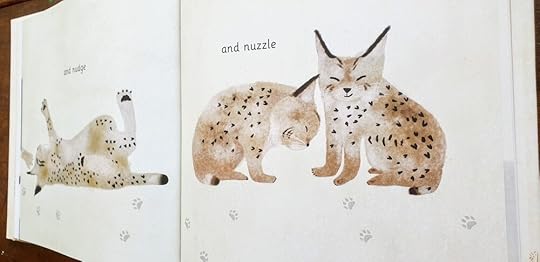
We All Play / kimêtawânaw by Julie Flett (Greystone Kids, 2021) | Illustration © 2021 by Julie Flett
As one review noted, the illustrations have an ‘enticing texture’. They make you want to reach out and sink your fingers into deep fur or scrunch them into someone’s warm jumper. Aside from being visually pleasing, this will only add to the appeal to young kids to whom the book is aimed.
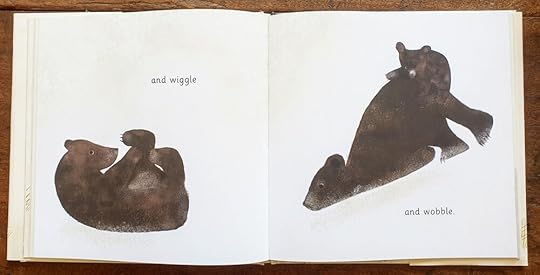
We All Play / kimêtawânaw by Julie Flett (Greystone Kids, 2021) | Illustration © 2021 by Julie Flett
One of my favourite spreads is of the bears in the snow who ‘wiggle and wobble.’ I have seen a shed load of bears in picture books. Flett’s bears are noteworthy for being so darn adorable and (appropriately enough) playful! Aside from their claws (which look razor-sharp), her animals look incredibly soft. And oh! that baby bear’s face!
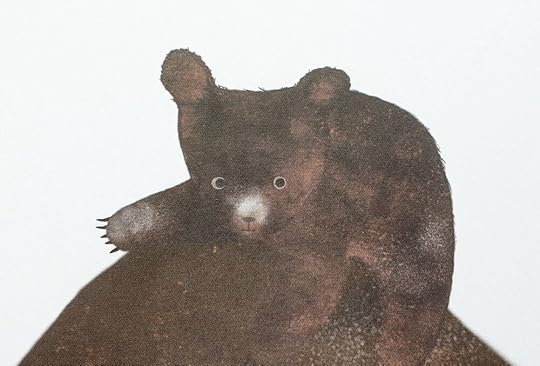
We All Play / kimêtawânaw by Julie Flett (Greystone Kids, 2021) | Illustration © 2021 by Julie Flett
Each spread uses playful alliteration to describes the featured animals. (For example, seals ‘bubble and bend.’ Buffalo ‘rumble and roll.’) Flett’s vocabulary is rich, and the text has a lilting, sing-song quality that makes it a pleasure to read aloud:
Animals hide and hop
And sniff and sneak
And peek and peep.
The text is minimal. Kirkus Reviews notes the ‘[a]nimals are not named within the primary text, leaving it to readers to identify the hopping bunnies, the spouting beluga whale calves, and the yawning wolf pups’. Yet despite its apparent simplicity, We All Play is clever and has several visual elements that might be conversation starters with young kids. For example, if you look closely at the opening spread, you’ll see a little grasshopper hiding and hopping alongside the rabbit. These features make We All Play a perfect book to share with the very young at whom it’s aimed.
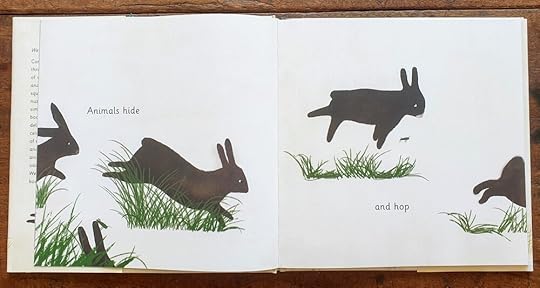
We All Play / kimêtawânaw by Julie Flett (Greystone Kids, 2021) | Illustration © 2021 by Julie Flett
Interspersed amongst the animals playing are groups of children (whose play reflects their animal counterparts). Lying in the grass or splashing in the water, the children repeat the joyful refrain, ‘We play too!’ (followed by the Cree translation: ‘kimêtawânaw mîna’).
In an interview with Art of the Picture Book, Flett shares why she likes to include Cree translation in her work:
When I started working on kids’ books, I was learning about the languages that my grandparents [spoke]… I thought this was something I could share with kids and ... contribute to my community through artwork and storytelling.
Elsewhere, Flett explains: “We didn’t have any books representing us, our parents or grandparents when we were growing up,” she says. “That hit me.”
Now Flett advocates for indigenous youth and other community members, helping to preserve (and share) indigenous languages among English-speaking populations. She also represents indigenous children through ‘the gorgeous skin tones [which] range from deep copper-brown to beige.’ (Horn Book Review). It’s so important that children of all races and colours (and abilities) get to see themselves represented in literature - and that includes picture books.
Flett’s Indigenous perspective is pretty unique. It allows her to quietly highlight her heritage, mainly through the inclusion of Cree and Michif languages. She explains:
“When I started working on kids’ books, I was learning about the languages that my grandparents had spoken, and I thought this was something I could share with kids and ... contribute to my community through artwork and storytelling.”
It’s significant, too, that in a cutaway scene of children swimming underwater, one girl has a malformed arm. I don’t mean it’s poorly drawn - Flett is way too good for that. Instead, it’s a thoughtful, inclusive moment where she has consciously chosen to portray a child with a disability. This is important because it reflects the world that children see around them - and that some individuals, unfortunately, experience first-hand.

We All Play / kimêtawânaw by Julie Flett (Greystone Kids, 2021) | Illustration © 2021 by Julie Flett
‘These are the small but important details that allow children to see themselves in books’ notes CM: Canadian Review of Materials. It’s a two-sided coin of tremendous value. One side affirms the child being represented. On the flip side, such details broaden other children’s horizons. They increase awareness and understanding and will encourage your child to look outwards at the experience of others.
We All Play is a message of unity. Flett presents a timely reminder (told through the subtle parallels of shared play) that we are all connected with nature and with each other - regardless of culture.
As the story draws to a close, the now-tired animals fall asleep ‘slowly, side by side’ and the children reply, ‘We do too.’

We All Play / kimêtawânaw by Julie Flett (Greystone Kids, 2021) | Illustration © 2021 by Julie Flett
We All Play / kimêtawânaw is a gentle and quiet book. It stands out for its beautiful, textural illustration and poetic text. Flett’s Cree-Metis heritage has shaped her work and purpose. But the inclusion of Cree words is not a gimmick. Rather than driving the book, it’s a beautiful addition that enhances the experience. (The end of the book has a list of featured animals in both Cree and English, with guidance on pronunciation.)
Most importantly, We All Play is an invitation – and opportunity – for you to engage with your child – and play! Because connection should be at the heart of every storytime.
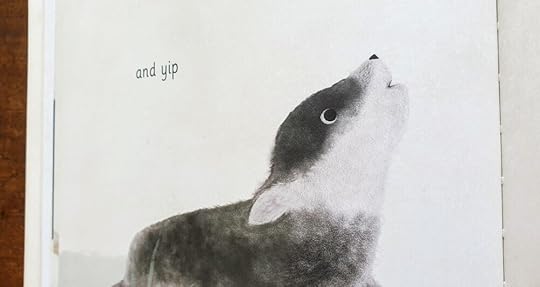
We All Play / kimêtawânaw by Julie Flett (Greystone Kids, 2021) | Illustration © 2021 by Julie Flett
STORIES WORTH SHARING: We All Play / kimêtawânaw by Julie FlettGood to Read because:
It’s a joyful celebration that diversifies your child’s bookshelf. Here’s how:
It introduces your child to a range of uncommon animals, including buffalo and bobcats.
The children depicted feature a range of (darker) skin tones.
The inclusion of some Cree words is a playful addition that broadens your child’s horizons.
The simple, sing-song text will engage young children. Perfect for reading aloud (and developing their literacy skills).
It reminds us that we are interconnected and live in relationship - to each other and to the natural world.
Picture books for younger children
Goodnight Moon by Margaret Brown and Clement Hurd
Maisy at the Farm by Lucy Cousins
Tiny Little Fly by Michael Rosen and Kevin Waldron
Say Hello to the Dinosaurs by Ian Whybrow and Tim Warnes
BUY THE BOOKPowered by Bookshop.org
Supporting independent bookshops
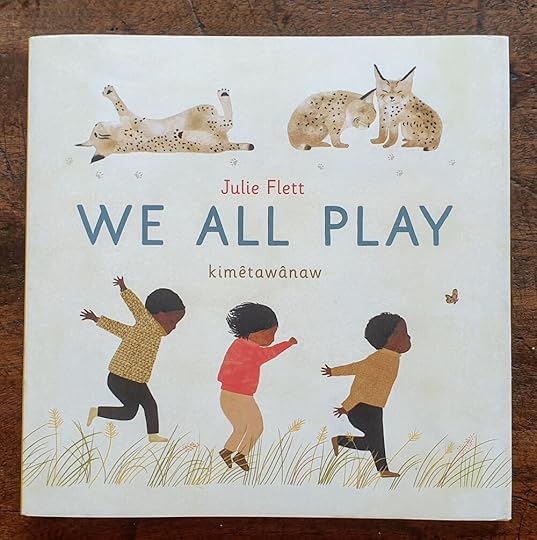
We All Play / kimêtawânaw by Julie Flett (Greystone Kids, 2021) | Illustration © 2021 by Julie Flett
‘spectacular in its seeming simplicity.’
- Seven Impossible Things Before Breakfast‘a great candidate for read-aloud and storytimes.’
- Canadian Review of Materials buy us bUY UK* I EARN COMMISSION FROM THESE LINKS #AD/AFFSOURCESWe All Play / kimêtawânaw by Julie Flett (Greystone Kids, 2021) Julie Flett (Julieflett.com) We all Play (Patricia Cambpell Clarkson, spiritualityandpractice.com)Julie Flett’s We All Play / Kimêtawânaw (Seven Impossible Things before Breakfast, 21 june 2021) An Interview with Julie Flett (The art of the picture book, 14 may 2021) Julie Flett is reclaiming Indigenous themes of community and language through her children's books (rYAN B. pARTICK, 30 JUNE 2020) Review of We all Play (Autumn Allan, The Horn Book Inc, 7 june 2021) We All Play = kimêtawânaw (Cmreviews.ca)Related articles****© 2021 BY TIM WARNES(UNLESS OTHERWISE ATTRIBUTED)USE OF THIRD PARTY COPYRIGHTED MATERIAL FALLS UNDER FAIR USE/FAIR DEALING PRACTICE.My Life in Books
For lovers of kid lit, this memoir - My Life in Books - is intended to give you the confidence and encouragement to share your own passion; to help you make lasting connections through kids’ books.
Originally posted at www.timwarnes.com ...more
- Tim Warnes's profile
- 30 followers



